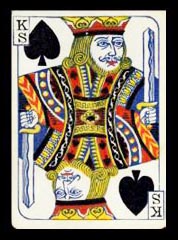
|
| « History of Playing Cards | Early Standards | Gallery of Playing Cards | Card Games Rules | CONTACT |
Samuel Hart
Playing Cards, History, America 19th Century
Samuel Hart was born to a family who had been booksellers and stationers in Philadelphia since 1831. Samuel Hart was to become acquainted with the business of stationary and paper manufacture from an early age. Among his family, were true masters of paper making and printing, and they had relatives from New York to Philadelphia involved in the stationary business. It was among these people, that sold books and made pencils, that Samuel Hart would emerge as one of the most significant figures in American card making history.
After learning his craft, he set up shop as a stationer in Philadelphia in 1844 and traded under the name "Samuel Hart & Co".
In 1849, he turned his hand to making playing cards and issued a number of decks in wrappers like "Hart's Linen Eagle". "Club House" and "London Club Cards" emblazoned with the usual eagle. His playing cards continued to be popular for many years and make up a considerable chapter in American playing card history.
Samuel Hart emerged from among a number of prodigies, who had turned their attention to stationary and card manufacture. At the time Samuel Hart was apprenticed, he had the good fortune of working under the guidance of Lewis I. Cohen, a renown American card master of the 19th century.
At the Cohen workshop, he also made the acquaintance of John J. Levy, and John M. Lawrence, and a number of others who would end up as young card masters in their own right, publishing successful brands from New York. The skill and craftsmanship with which these cards are made, make them outstanding examples of the period in terms of quality and refinement.
Samuel Hart occupies a considerable position in American playing card history, not the least for which he was responsible for a number of important firsts, all of which would come into widespread common use by the turn of the century. These included double-ends, rounded corners, and satin finishes. It was not so much that he was the first one come up with these ideas, or to have invented them. Samuel Hart was the first to commercially produce them, and put them in widespread circulation. Both the brands "Mogul" and "Steamboat" of the 1850s are examples. Though, for many years yet, double-ended court cards would remain much of a novelty in America, and single ended court cards remained the ones in most widespread use.
Samuel Hart is also credited with introducing the Joker to the Deck which seems to appear around the 1860s. In the mid 1800s Euchre was enjoying popularity in the United States. The game required an extra trump, or Best Bower and the Joker fulfilled that role.
In 1871, the card manufacturing ventures of Lawrence & Cohen, John J. Levy, and Samuel Hart & Co., joined forces to form the New York Consolidated Card Company.

The cards that came out of the New York Consolidated Card Company continued to offer developments and refinements. "Squeezers", which are also said to have been invented by Hart, were issued by the New York Consolidated Card Co. in the early 1870s. These were playing cards with miniatures in the corners which enabled the player to "squeeze" his hand into a tight, secretive fan and yet still easily read the value of his cards. "Squeezers" were in effect precursors to corner-side indices, and similar inventions were being developed by rival card makers.
Card Masters of the |
||||||||
| Thomas de la Rue | ||||||||
| Lewis I. Cohen | ||||||||
| Lawrence & Cohen | ||||||||
| Samuel Hart | ||||||||
| Andrew Dougherty | ||||||||
| Ferdinand Piatnik | ||||||||
| ||||||||
|
||||||||
| ||||||||
|